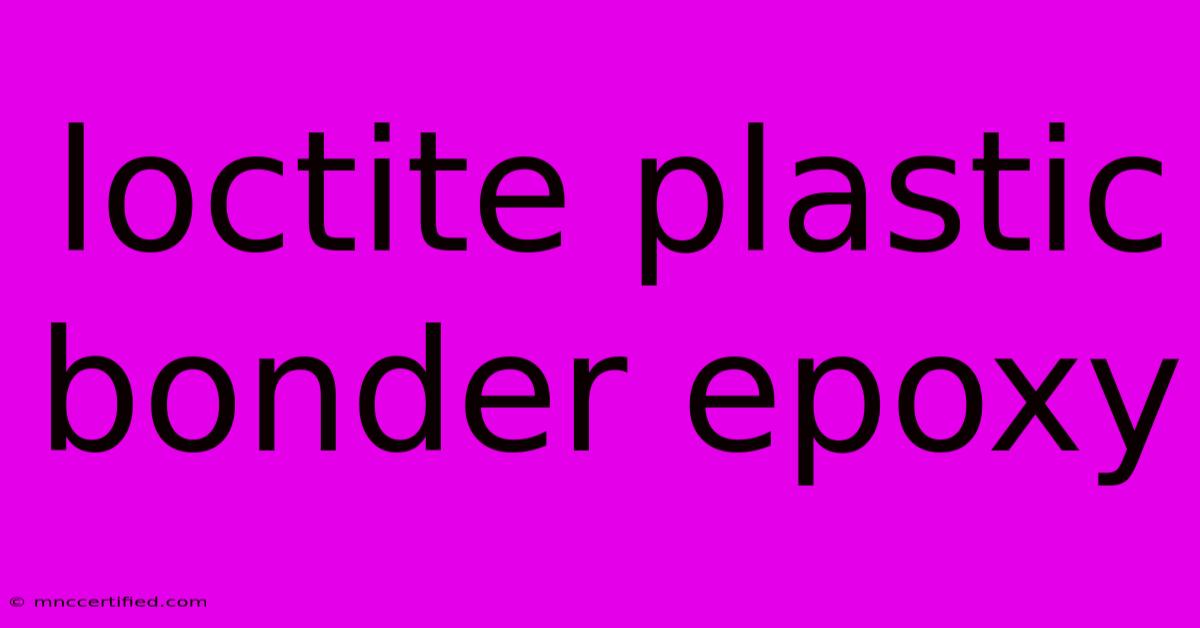Loctite Plastic Bonder Epoxy

Table of Contents
Loctite Plastic Bonder Epoxy: A Comprehensive Guide
Loctite is a name synonymous with reliable adhesives, and their plastic bonder epoxy is no exception. This powerful adhesive is a go-to solution for countless DIY projects and professional repairs, offering a strong, durable bond for a wide variety of plastics. But with so many options available, understanding which Loctite plastic bonder epoxy is right for your needs and how to use it effectively is crucial. This comprehensive guide will cover everything you need to know.
Understanding Loctite Plastic Bonder Epoxy
Loctite offers a range of plastic bonders, each formulated for specific applications and plastic types. Understanding the differences is key to achieving a successful bond. While the exact formulations vary slightly, most Loctite plastic bonders share several key characteristics:
- Two-part epoxy: This means the adhesive consists of a resin and a hardener, which must be mixed thoroughly before application. This two-part system ensures a strong chemical reaction, resulting in a robust bond.
- High-strength bond: Loctite plastic bonders are designed to create a strong, durable bond that can withstand significant stress and strain.
- Versatile applications: They can be used on a variety of plastics, though it’s essential to check the product’s specifications for compatibility.
- Gap-filling properties: Many Loctite plastic bonders possess gap-filling capabilities, making them ideal for repairing cracked or broken plastic parts.
- Ease of use: While precision is important, applying Loctite plastic bonder is generally straightforward, making it suitable for both beginners and experienced users.
Choosing the Right Loctite Plastic Bonder
The specific type of Loctite plastic bonder you choose will depend on several factors:
- Type of plastic: Not all Loctite plastic bonders are compatible with all types of plastic. Always check the product label for compatibility information. Common plastics include ABS, acrylic, polycarbonate, and fiberglass-reinforced plastics.
- Strength requirements: Some applications demand higher strength bonds than others. Loctite offers various formulations with differing bond strengths.
- Gap size: If you're dealing with a significant gap between the parts you're bonding, you'll need a plastic bonder with good gap-filling capabilities.
- Cure time: Cure times vary depending on the specific product and environmental conditions. Consider the time you have available for the repair.
Tip: Consult the Loctite website or product packaging for detailed compatibility charts and instructions for your specific needs.
How to Use Loctite Plastic Bonder Epoxy
Proper application is crucial for achieving a strong and lasting bond. Follow these steps for optimal results:
-
Surface Preparation: This is the most critical step. Thoroughly clean and degrease the surfaces to be bonded using a suitable solvent like isopropyl alcohol. Remove any dust, debris, or contaminants. Roughening the surfaces slightly with sandpaper can also improve adhesion.
-
Mixing the Epoxy: Carefully measure and mix the resin and hardener according to the manufacturer's instructions. Thorough mixing is essential for optimal performance. Use a clean mixing stick or spatula.
-
Application: Apply a thin, even layer of the mixed epoxy to one of the surfaces. Avoid using excessive amounts.
-
Bonding: Firmly press the two surfaces together and clamp or hold them in place until the epoxy cures. The clamping pressure and cure time will vary depending on the specific product. Refer to the manufacturer's instructions for details.
-
Curing: Allow the epoxy to cure completely. Avoid disturbing the bond during the curing process. Cure times can range from a few minutes to several hours, depending on the product and environmental conditions.
Troubleshooting Common Problems
Even with careful application, issues can arise. Here are some common problems and solutions:
- Weak Bond: This is often due to improper surface preparation or insufficient mixing of the epoxy. Re-do the process, ensuring meticulous cleaning and thorough mixing.
- Incomplete Cure: This can be caused by low temperatures or high humidity. Ensure proper environmental conditions as per the product instructions.
- Incompatible Plastics: Using the wrong adhesive for your plastic type will result in failure. Always verify compatibility before proceeding.
Off-Page SEO Considerations for Ranking High on Google
To improve your blog post's search engine optimization (SEO) beyond on-page strategies, consider these off-page techniques:
- High-quality backlinks: Reach out to relevant websites and blogs in the DIY, repair, or home improvement niche and ask for a link to your article. Focus on sites with high domain authority.
- Social media promotion: Share your article on relevant social media platforms like Pinterest, Instagram, and Facebook, using targeted hashtags.
- Community engagement: Participate in online forums and communities related to DIY and repairs, subtly mentioning your article when relevant and providing helpful advice.
By following these steps, you can create a comprehensive and well-optimized blog post about Loctite plastic bonder epoxy, enhancing its visibility and chances of ranking high in Google search results. Remember to always prioritize user experience and provide valuable, accurate information.

Thank you for visiting our website wich cover about Loctite Plastic Bonder Epoxy. We hope the information provided has been useful to you. Feel free to contact us if you have any questions or need further assistance. See you next time and dont miss to bookmark.
Featured Posts
-
Bebe Amour Bonding Comforter
Nov 30, 2024
-
Indemnity Bond Sample Format
Nov 30, 2024
-
Montgomery County Bail Bonds
Nov 30, 2024
-
Nebraska Vs Iowa Game Time And Channel
Nov 30, 2024
-
Savannah Bond Manuel Ferrara
Nov 30, 2024